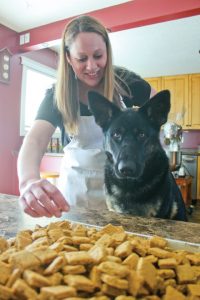
Nicole Sztabkowski and her German Shepherd Lexi with a recently completed batch of dog treats.
Photo By Matt Preprost
Worried about a pet food industry gone to the dogs, Nicole Sztabkowski crafts up treats safe for pooches — and people too
April 18, 2018
Like many, Nicole Sztabkowski wants to be able to read and understand the ingredient labels on the food she’s buying, and not just when it comes to feeding her family — but when she feeds her pets too.
So when her dogs were getting repeatedly sick from popular name brand pet foods, she started to researching all of their ingredients and was surprised by what she learned — an industry operating with limited regulations, and commonly used ingredients that may be fine for humans, but can prove deadly to pets.
“You have a hard time finding hard and fast rules,” Sztabkowski said. “You really have to trust who you’re buying your food from.”
Pet food sold in Canada is subject to industry regulations, mostly for packaging, labelling and advertising, but there are few rules that regulate what kind of ingredients can be used to formulate products.
Studies have found some additives and preservatives found in pet food can be toxic, and even mislabelled — that chicken meat source one may think they’re feeding their pet may not be chicken at all, according to university researchers in California.
“My dogs kept getting sick off their kibble,” said Sztabkowski, owner of three dogs and two cats. “I had to change through a couple of different foods because of it, but nothing helped.”
So last year, Sztabkowski switched her dogs to a raw diet, and decided to experiment with a few simple ingredients of her own: oats, eggs, unsweetened apple sauce, natural cheeses, to name a few.
“I love when I’m rolling out my mix. You can see the cheese, you can see the real ingredients,” said Sztabkowski, a cake decorator by trade who owned a business in the Northwest Territories before moving to Fort St. John.
“People always laugh at me because I eat the dog treats, the peanut butter ones especially. They’re my favourite.”
Sztabkowski started making treats for her pups on a personal scale, before word spread to others looking for healthier options for their pets. An artisan and business were made.
Sztabkowski started last September about making 50 small bags of her K-9 Crunchies a week with a small mixing bowl. Sztabkowski soon found herself in need of a larger mixer and ramp up production to 150 bags a week, filling orders for local markets and pet food stores, while shops in Grande Prairie also put themselves on the order list.
The work has increased, but the ingredient basics are the same — flax, pumpkin, lavender, chamomile, to name some others, all “sit next to the same ingredients I use to bake cupcakes,” said Sztabkowski, who has branched off into making pet soaps too.
“Since I started, people keep telling me about their dogs’ allergies” from store-bought products, she said. “People want more natural ingredients, things they can trust. You want to be able to read a label and relate to it.”
When it comes to small business startups, innovation is key and artisans are poised to find it, even from their kitchen counter, said Nelson Stowe, president of the Fort St. John Chamber of Commerce.
“The real benefit for someone with an innovative idea is that, due to the internet, their market is the world, it’s not just Fort St. John,” Stowe said.
“With the internet today, where everything is available to everyone regardless of where you are, you can implement innovative ideas and products.”
Every business starts from zero, Stowe said. The toughest challenge, especially for artisans, is growing from there, he said.
“The toughest struggle for small business is the beginning, and going from a one-person show to a second-person show, to a third,” Stowe said, noting Sztabkowski could soon find herself outgrowing her home kitchen and into a commercial one, if her popularity grows.
“There are numerous entrepreneurial programs that can fund some of these initial startups.”
As she ventures into the pet food industry, Sztabkowski knows she still has much to learn. There are few resources about starting a pet food company, and suggested standards can be vague, she said. At the very least, Sztabkowski sends her treats to the U.S. to be tested for its nutritional content of protein, fat, fibre, moisture, and calories.
“It seems to me no one is looking out for our pets,” she said. “Whether its treats or everyday food and nutrition, our dogs need better.”
Photo Nicole Sztabkowski and her German Shepherd Lexi with a recently completed batch of dog treats.
Photo By Matt Preprost








